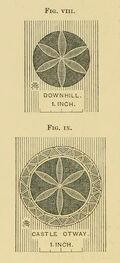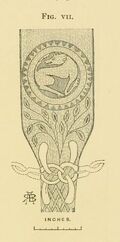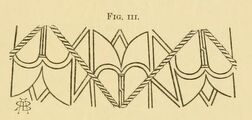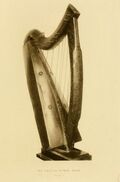
Volume 1 of “Musical Instruments” by Robert Bruce Armstrong. Pages 73-79.
The Castle Otway harp was made by Cormac O'Kelly about the year 1700 for a person of consequence, but found itself in the hands of notable harpist Patrick Quin.
The content of this article was quoted from "Musical Instruments" by Robert Bruce Armstrong.[1] The book can be downloaded and read for free by following the link in the references. For your convenience, the relevent section can be read below.
Book Excerpt[]
Corroborating Mentions[]
Of this Harp we have three very brief notices. The first of these occurs in Bunting's coll. of 1809, [2] either by the editor or by Mr. Henry Joy, and is as follows : "A Harp made by Cormack O'Kelly, of Ballynascreen, in the County of Londonderry, about the year 1700," has the figure of wolf-dogs engraved upon the front pillar. The second is undoubtedly by Bunting, who writes: "Quin's Harp was made by the same artist (Cormac O'Kelly, Ballynascreen, Coy. Derry). The editor saw it at Egan's, the late harp-maker's in Dublin. It was a handsome instrument, made, as usual, of red sallow from the bog. It bears date 1707." [3] The third is by Dr. Petrie, who states that he saw the Harp, that it " bears the date 1707," and that it was, when he wrote, at Castle Otway. [4]
Ownership[]
At what time it became the possession of the Otway family cannot be stated, for when the late Admiral Otway succeeded to the estate in 1850 the harp was at Castle Otway, and it was not known when or from whom it had been acquired.
Harp Craftmanship[]
This Harp is an extremely interesting and profusely decorated instrument. The box is cut out of a solid block; but the projecting block which has been fitted into a cavity in the stand by which the Harp is now supported is scarcely visible. The fore-pillar is slightly curved, and has not been shortened by the tension of the strings. The harmonic curve has the prominent peak which may be seen upon the Irish Harp illustrated by Pretorius, and reproduced p. 26.
Soundbox[]
The box of this instrument is graceful in form. The sounding-board, which terminates upon either side of the projecting block in straight lines, has four sound-holes. These have hexafoil ornaments enclosed in circles, each of which is surrounded by two concentric circles enclosing chevron ornamentation (Fig. viii.). The edges of the sounding-board had semicircular decoration similar to that upon the fore-pillar of the Kildare Harp (see p. 70), but little of this ornamentation remains. The raised string band, which terminates in the treble in semicircular curves and in the bass in steps, is 1 5/8 in. broad, and was apparently curved along the strings, the rise in the centre being 1 5/8 in. There were, properly speaking, no "shoes of the strings"; but pieces of thin brass, formed at the sides into elongated curves and with holes for the strings in the centre of the corresponding curves, took their place. These pieces of brass are fastened by nails upon either side of the string-holes, and have for ornamentation two parallel lines of projecting knobs; and as the metal is thin, and the pieces are not of considerable length, they could not have interfered with the vibration

of the instrument (Fig. i.) There are thirty-five string-holes : where these occur in the treble the strings have probably cut the string band and a piece of wood with new holes has been inserted. The shortest string is 2 1/4 in., the longest 30 1/2 in. The sounding-board is of unusual thickness, near the treble it is 3/16 in., and near the bass 3/4 in. thick. At the upper extremity the sounding-board is 3 3/4 in. in width, and at the lower termination it is 12 1/2 in. wide. At the upper portion of the box the angles are rounded off; here the measurement from the sounding-board to the back of the box is 5 in., and Fio. n. the width 4 1/2 in. The sides of the box are 2 ft. 11 3/4 in. in length. The depth at the upper extremity, owing to the rounding off of the angles, is 4 in., about the centre 4 3/8 in., and at the lower termination 3 1/2 in.
Harmonic Curve[]
The harmonic curve is finely formed. At the bass termination there is a brass enrichment, the face of which was relieved by five nails with ornamented heads, one of which remains. The sides of this enrichment are ornamented in a series of inverted chevrons between four elongated drooping curves. A series of indents above the curves are carried over the chevrons, forming a waving line with pendants to the points of the chevrons. Above each curve the metal is pierced by a round hole (Fig. ii.). Between this enrichment and the projecting peak the decoration is
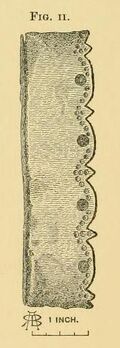
largely in the form of chevrons shown by rope pattern. Within each chevron the

decorator has represented a portion of an arcade of semicircular arches (Fig. iii.). This chevron pattern, which terminates at either end in foliaceous designs, does not extend further than the projecting peak, behind which upon either side there are fine interlaced patterns

(Fig. iv.). Above and between these patterns a thin line of rope moulding extends towards the box, and similarly decorated bands are carried downwards upon either side behind the interlaced patterns, thus forming a cross (Fig. v.). The bands for the tuning-pegs, which are brass, form single curves and have saw-tooth edgings. These bands, of which small portions are missing, [5] were pierced for thirty-four pegs, nine of which remain, and are ornamented (Fig. v.). The decoration is the same upon either side. The harmonic curve is of the ancient form, that is, it has a cavity underneath into which the fore-pillar is inserted. This cavity is considerably nearer the right side than the left (Fig. vi.). The length of the
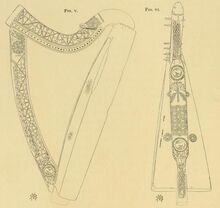
harmonic curve is 2 ft. 2 3/8 in. The depth after it leaves the box is 3 in., where the peak occurs 4 7/8 in., about the centre 4 in., and at the bass termination 4 7/8 in. The thickness of the lower portion is 2 in.
Fore-Pillar[]
Upon either side of the fore-pillar the ornamentation is practically the same. At the lower extremity there is a narrow band with rope moulding, which is carried along the outer edge until the T formation is reached. Within the angle formed by this and another rope moulding along the termination of the pillar, there is a foliaceous pattern, then a representation of a wolf-dog within a circle and surrounded by two concentric circles with chevron ornamentation, and above a foliaceous pattern. Chevron ornamentation, with arcade decoration similar to that already described, occurs until the upper portion of the T formation is reached, where there is a foliaceous pattern, above which a circle with interlaced pattern, and at the upper extremity a parallelogram with widely spaced interlaced pattern. At either side, and at the commencement and termination of the T formation, a gradually diminishing rope carved in relief, to be hereafter referred to, is carried along the angle formed by the flange and the fore-pillar, while the flange itself is covered by a foliaceous pattern (Fig. v.).
The front of the fore-pillar (Fig. vi.) is very finely decorated. From where it joins the projecting block an elongated and open interlaced pattern is carried up for 7 1/4 in., when it joins a singular ornament (Fig. vii.).

It is difficult to determine what the artist intended to represent. The strands of two ropes are distinct. These become twisted, and, as already noticed, are carried along the back of the T formation and gradually diminish. This portion of the ornamentation upon the front is in low relief, while the ropes already referred to are in high relief. These and similar ornaments are the only portions of the decoration which are not incised. Above this ornament and at the commencement of the T formation there is a foliaceous pattern spreading out on either side, above which, enclosed in a circle with chevron ornamentation, there is a representation of a wolf-dog in a crouching attitude with his head turned backwards (Fig. vii.). [6] It will be found that three other representations of this animal occur with very slight variation. There can be no question as to the position in which the artist intended these representations of wolf-dogs to be viewed. That represented upon the right side of the fore-pillar, when seen as it would be were the Harp resting upon the back of the box, is in precisely the same position as the representations upon the front of the fore-pillar, while that on the left side, when viewed iu the same manner, appears to be sitting more upon the haunches (Fig. v.). Above the wolf-dog there is a double representation of the interlaced pattern before referred to, and a date-palm in fruit. The wolf-dog is again represented, also the ornamentation in low relief showing the strands of the ropes, while an elongated and open interlaced pattern extends to the harmonic curve (Fig. vi.).
The length of the fore-pillar along the outer curve is 35 1/2 in. The width at the lower end is If in. Across where the lower wolf-dog occurs is 31/2 in.; across the upper wolf-dog 2 3/4 in. The width at the upper extremity is 1 1/2 in.; the depth both of the upper and lower extremities is 3 3/8 in., and at the centre 2 7/8 in. The width at the back is 1 1/8 in. The flange at the back of the T formation is 1 1/4 in. deep.
Name Carving & Repairs[]
Upon the back of the fore-pillar, that is the portion nearest to the box, the figures 1410 are incised, immediately following which the name Cormac O'Kelly rudely carved can be indistinctly traced, after which there are letters or figures now scarcely visible. It is strange to find a maker's name carved in very rude characters upon an instrument so richly and delicately decorated. This harp is of a purely Celtic form, and has no resemblance to the genuine Cormac O'Kelly preserved at Downhill, except in having the sound-holes similarly ornamented, and sound-holes of both the harps are here represented for comparison. (Fig. viii & Fig. ix) [7]
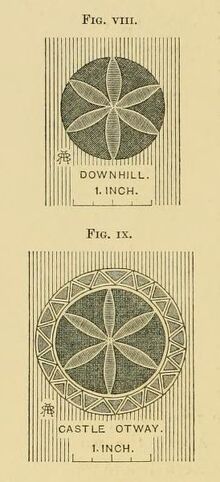
The Castle Otway Harp has all the appearance of having been constructed during the first half of the seventeenth century, while the Downhill instrument is dated 1702. It is certain that the Castle Otway Harp required to be repaired at some period, and certain repairs were executed upon the upper portion of the string band. The Harp may have been intrusted to Cormac O'Kelly for that purpose, and he may have carved his name and copied the ornamental sound -holes when constructing the Downhill instrument. The date "about 1700" or of " 1707," stated by Joy, Bunting, and Petrie to be upon it, is not visible, but the figures
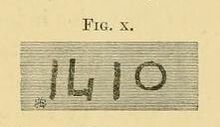
1410 are distinctly so (Fig. x.). [8] In 1410 figures would most probably have been carved in relief, whereas in this case they are incised. Again, Arabic numerals were probably not in use in 1410. If these figures are examined in reverse they represent 0171, and this is probably what Joy, Bunting, and Petrie noticed.
There are ten strings of copper wire upon the Harp. These are simply to keep the three portions of the instrument together. The box and fore-pillar are much worm-eaten; the harmonic curve, which is apparently of different wood, is well preserved. The patterns upon the Harp are, with the exceptions noticed, indicated by incised lines, and in some places it appears that colour-staining has been resorted to to increase the effect, — red, and a darker colour being traceable. For illustration showing the back of the Harp see p. 28.
Made For Whom[]
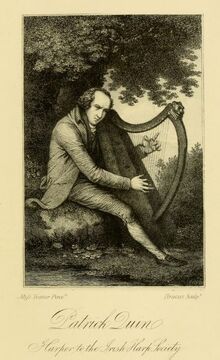
This Harp, which is still preserved at Castle Otway, Templemore, [9] was no doubt made for a person of consequence. It must have been an old instrument when it came into the possession of Patrick Quin, a blind harper of note, and, as it has been associated with his name, the reader may care to know what has been recorded concerning him. He was born in 1745, and resided at Portadown, County Armagh, and had for his instructor Patrick Linden of the Fews, County Armagh, a distinguished harper and poet. He attended the Belfast meeting in 1792, upon which occasion he played besides other tunes "Patrick's Day," harmonised by himself, which tune had not been previously played upon the harp. He was appointed teacher to the Dublin Harp Society, and played at two concerts at the Rotunda in that city in 1809 in commemoration of Carolan, where his performance was so well received that he for the future declined playing upon the violin, which he had previously been accustomed to do. [10] An engraved portrait of Quin was exhibited at the Musical Loan Exhibition, Feis Cecil, 1899. [11]
Photo Gallery[]
Today[]
The harp is in storage at Trinity College, Dublin, Ireland, and is not normally on display.
Further Reading[]
Excerpt's References[]
Numbers 2-11 are footnotes found in the excerpt. For more information, refer to the original text.
- ↑ Armstrong, Robert Bruce. "Musical Instruments: Free Download." Internet Archive. Edinburgh: David Douglas, 1904, n.d. Web. 20 Apr. 2016. <https://archive.org/details/musicalinstrumen01arms>.
- ↑ Note, p. 24.
- ↑ Coll. 1840, Note, p. 76.
- ↑ O'Curry's Lectures, vol. iii., pp. 294, 295-297.
- ↑ The bands were not sufficiently strong to withstand the strain, so a breakage has occurred, that on the right side, where it was pierced for the second tuning-peg.
- ↑ The illustration is from a rubbing by Miss Otway-Ruthven, and from a photograph.
- ↑ Both illustrations are from rubbings.
- ↑ The illustration is from a rubbing.
- ↑ The writer is indebted to Mrs. Otway Ruthven, of Castle Otway, for allowing the Harp to be photographed for the purpose of illustrating this work, and also to Miss Otway-Ruthven for an excellent drawing and rubbings of portions of the ornamentation.
- ↑ Bunting, coll. 1840, pp. 64-82. From Hardiman we learn that even as late as 1831 strains of Patrick Quin, an old Irish harper, who performed publicly in Dublin in 1809, were still remembered with delight." — Irish Minstrelsy, vol. i. p. 181.
- ↑ Catalogue, No. 103. Had a copy of this engraving been in the British Museum, the writer would have endeavoured to have had it reproduced. The Joly collection, the most important in Ireland, is not available, and could not be examined.

